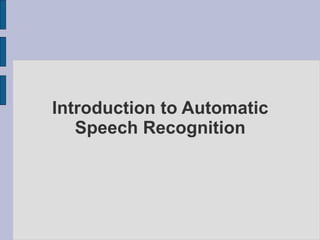
Voice recognitionr.ppt
- 1. Introduction to Automatic Speech Recognition
- 2. Outline Define the problem What is speech? Feature Selection Models Early methods Modern statistical models Current State of ASR Future Work
- 3. The ASR Problem There is no single ASR problem The problem depends on many factors Microphone: Close-mic, throat-mic, microphone array, audio-visual Sources: band-limited, background noise, reverberation Speaker: speaker dependent, speaker independent Language: open/closed vocabulary, vocabulary size, read/spontaneous speech Output: Transcription, speaker id, keywords
- 4. Performance Evaluation Accuracy Percentage of tokens correctly recognized Error Rate Inverse of accuracy Token Type Phones Words* Sentences Semantics?
- 5. What is Speech? Analog signal produced by humans You can think about the speech signal being decomposed into the source and filter The source is the vocal folds in voiced speech The filter is the vocal tract and articulators
- 12. Feature Selection As in any data-driven task, the data must be represented in some format Cepstral features have been found to perform well They represent the frequency of the frequencies Mel-frequency cepstral coefficients (MFCC) are the most common variety
- 13. Where do we stand? Defined the multiple problems associated with ASR Described how speech is produced Illustrated how speech can be represented in an ASR system Now that we have the data, how do we recognize the speech?
- 14. Radio Rex First known attempt at speech recognition A toy from 1922 Worked by analyzing the signal strength at 500Hz
- 15. Actual speech recognition systems Originally thought to be a relatively simple task requiring a few years of concerted effort 1969, “Wither speech recognition” is published A DARPA project ran from 1971-1976 in response to the statements in the Pierce article We can examine a few general systems
- 16. Template-Based ASR Originally only worked for isolated words Performs best when training and testing conditions are best For each word we want to recognize, we store a template or example based on actual data Each test utterance is checked against the templates to find the best match Uses the Dynamic Time Warping (DTW) algorithm
- 17. Dynamic Time Warping Create a similarity matrix for the two utterances Use dynamic programming to find the lowest cost path
- 18. Hearsay-II One of the systems developed during the DARPA program A blackboard-based system utilizing symbolic problem solvers Each problem solver was called a knowledge group A complex scheduler was used to decide when each KG should be called
- 19. Hearsay-II
- 20. DARPA Results The Hearsay-II system performed much better than the two other similar competing systems However, only one system met the performance goals of the project The Harpy system was also a CMU built system In many ways it was a predecessor to the modern statistical systems
- 23. Acoustic Model For each frame of data, we need some way of describing the likelihood of it belonging to any of our classes Two methods are commonly used Multilayer perceptron (MLP) gives the likelihood of a class given the data Gaussian Mixture Model (GMM) gives the likelihood of the data given a class
- 25. Pronunciation Model While the pronunciation model can be very complex, it is typically just a dictionary The dictionary contains the valid pronunciations for each word Examples: Cat: k ae t Dog: d ao g Fox: f aa x s
- 26. Language Model Now we need some way of representing the likelihood of any given word sequence Many methods exist, but ngrams are the most common Ngrams models are trained by simply counting the occurrences of words in a training set
- 27. Ngrams A unigram is the probability of any word in isolation A bigram is the probability of a given word given the previous word Higher order ngrams continue in a similar fashion A backoff probability is used for any unseen data
- 28. How do we put it together? We now have models to represent the three parts of our equation We need a framework to join these models together The standard framework used is the Hidden Markov Model (HMM)
- 29. Markov Model A state model using the markov property The markov property states that the future depends only on the present state Models the likelihood of transitions between states in a model Given the model, we can determine the likelihood of any sequence of states
- 30. Hidden Markov Model Similar to a markov model except the states are hidden We now have observations tied to the individual states We no longer know the exact state sequence given the data Allows for the modeling of an underlying unobservable process
- 31. HMMs for ASR First we build an HMM for each phone Next we combine the phone models based on the pronunciation model to create word level models Finally, the word level models are combined based on the language model We now have a giant network with potentially thousands or even millions of states
- 32. Decoding Decoding happens in the same way as the previous example For each time frame we need to maintain two pieces of information The likelihood of being at any state The previous state for every state
- 33. State of the Art What works well Constrained vocabulary systems Systems adapted to a given speaker Systems in anechoic environments without background noise Systems expecting read speech What doesn't work Large unconstrained vocabulary Noisy environments Conversational speech
- 34. Future Work Better representations of audio based on humans Better representation of acoustic elements based on articulatory phonology Segmental models that do not rely on the simple frame-based approach
- 35. Resources Hidden Markov Model Toolkit (HTK) http://htk.eng.cam.ac.uk/ CHIME ( a freely available dataset) http://spandh.dcs.shef.ac.uk/projects/chime/PCC /datasets.html Machine Learning Lectures http://www.stanford.edu/class/cs229/ http://www.youtube.com/watch?v=UzxYlbK2c7E